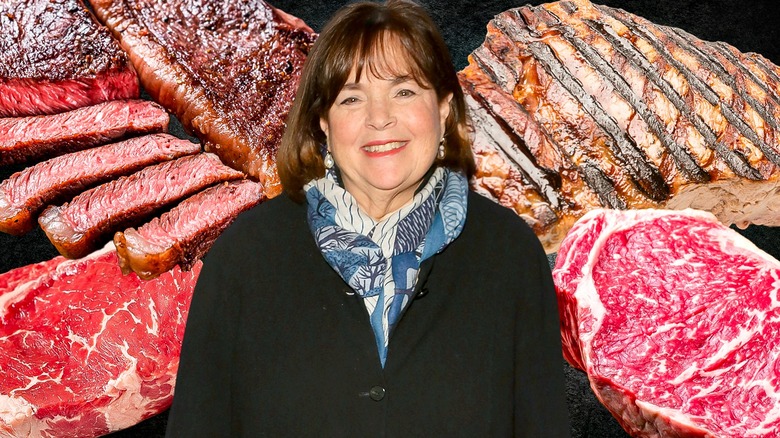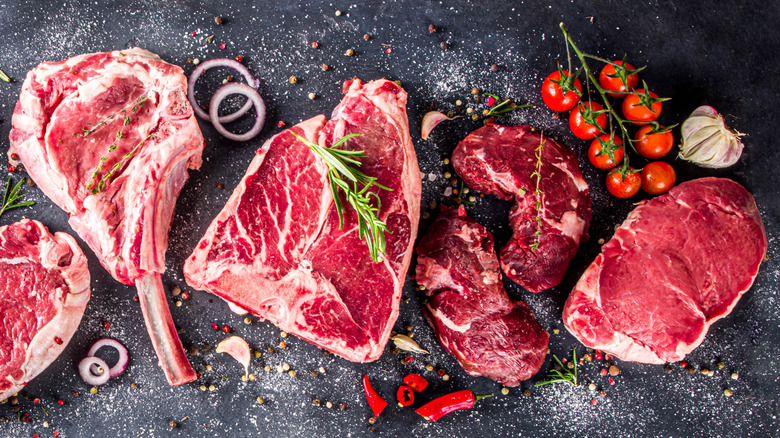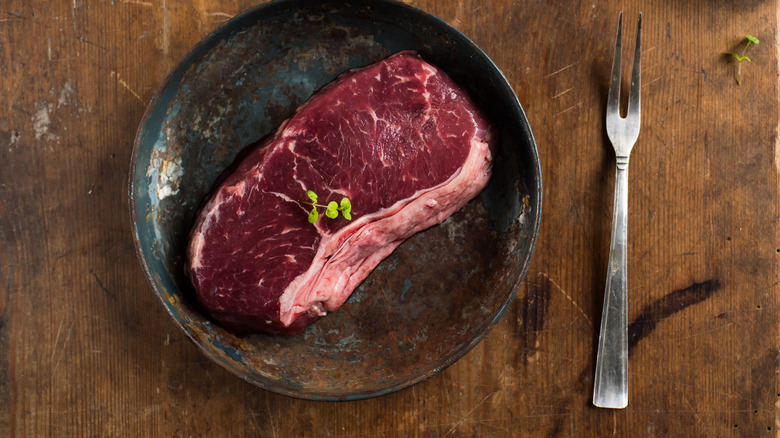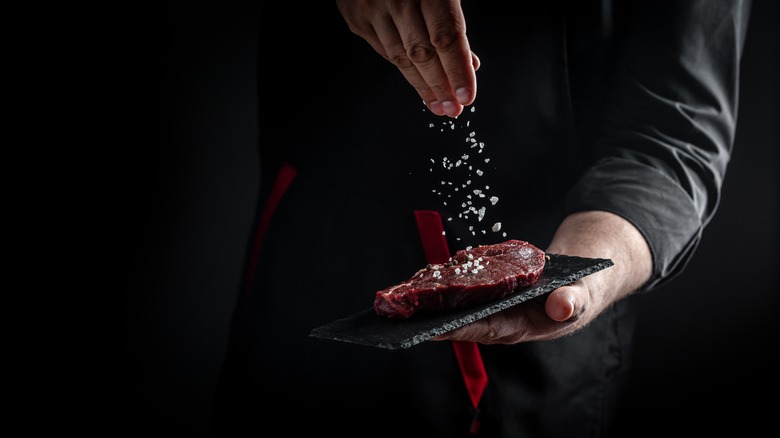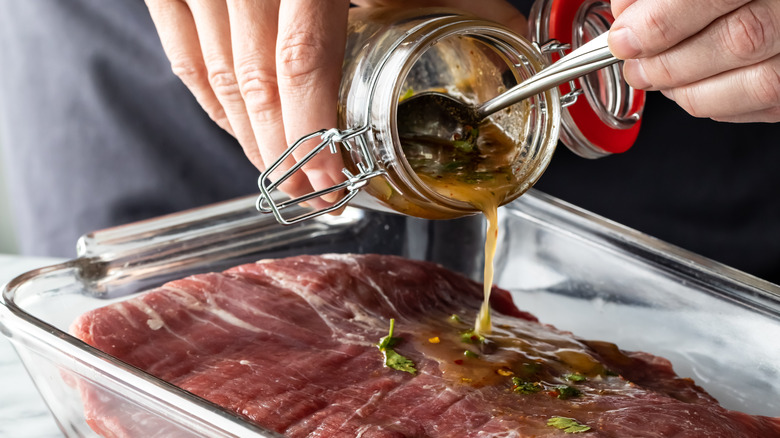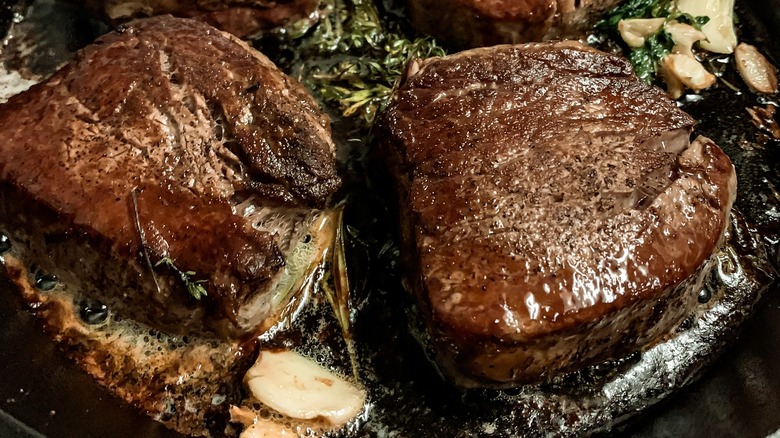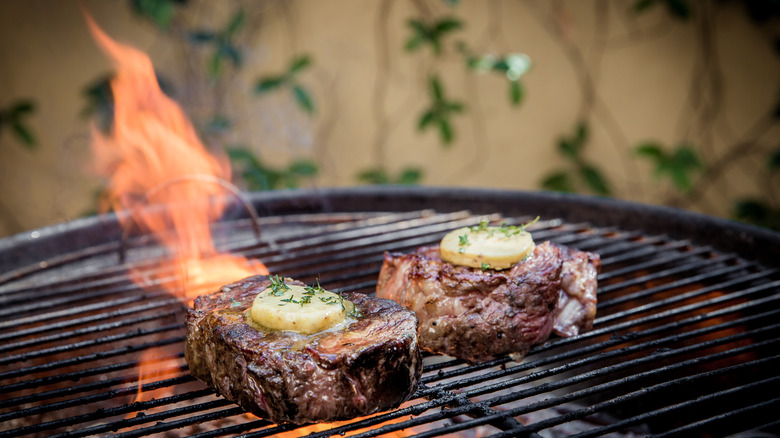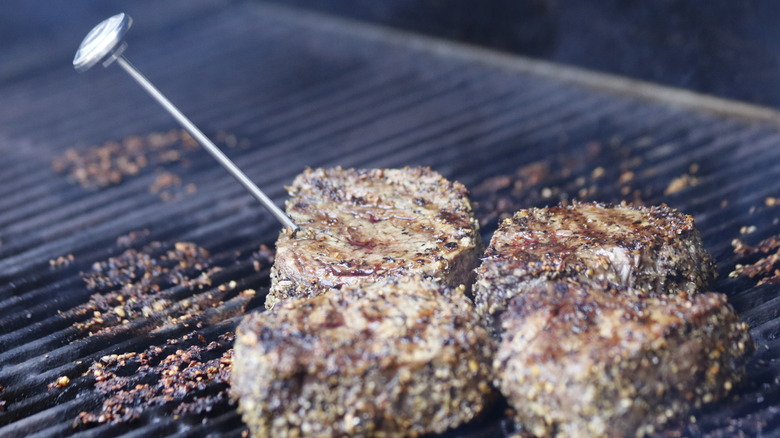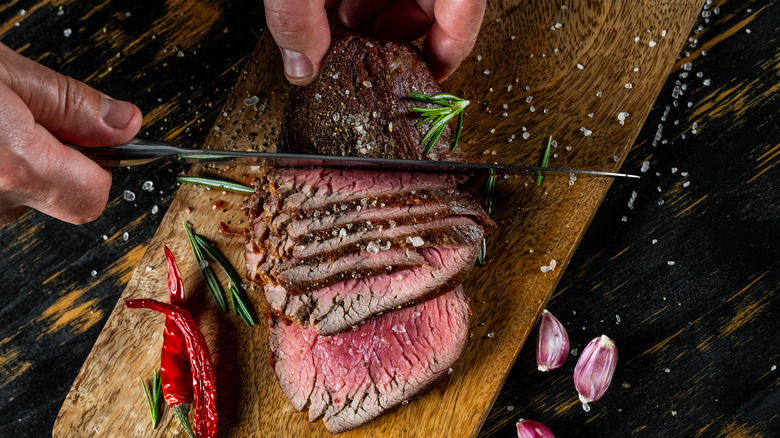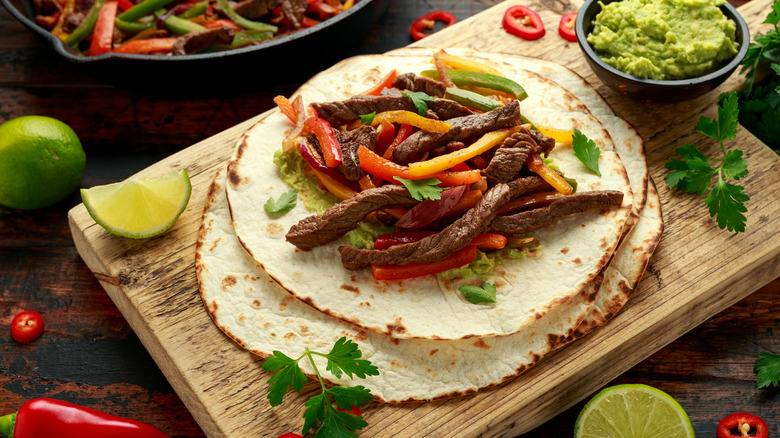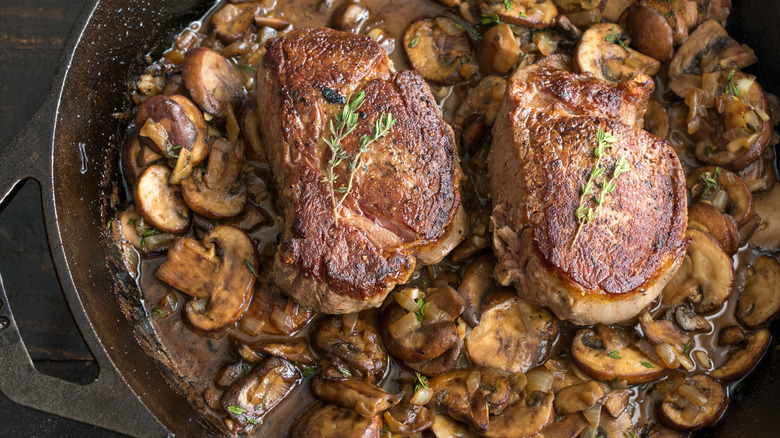Ina Garten's 10 Tips For Cooking Perfect Steaks
Ina Garten is famous for her comforting dishes and simple, elegant techniques, so why should cooking steak be anything but marvelous with her in your corner? From pot roast to casserole, her always fabulous takes on the classics is why we trust her to help us when trying new things in the kitchen. Ina Garten once had a notorious aversion to cooking steak on an outdoor grill but managed to face her fears. This resulted in her figuring out an invaluable secret for grilling steaks that's nothing short of foolproof (more on that later).
You'll feel confident whether you make her "steakhouse steaks" in a cast-iron pan or prepare dishes like steak fajitas or steak sandwiches. Ina's tips make everything from preparing steak for cooking, to the final flourish of seasoning, fun and creative. She's not short on ideas when it comes to additional ingredients to amp up your already amazing steak. Her dry rubs, seasoning choices, and unique sauces are brimming with flavor which can inspire your tastebuds. It's time to discover some of Ina Garten's top tips for cooking perfect steaks for any occasion.
Choose the right cut of steak
Ina Garten isn't shy about her preferences for specific cuts of steak. Her choices aren't as much about one cut winning out over another, but instead, focus on how the steak is cooked. Filet mignon is Ina's go-to for her method of searing steak in a cast-iron pan and finishing in the oven. She calls this technique "steakhouse style," one of her most well-known steak preparations. The filet mignon's thickness of about 2 inches is perfect for being cooked in the pan. A larger, thicker sirloin steak would be too big for her searing method. The filet mignon's leanness is also ideal since it won't dry out and remains tender from the pan to the plate. The precious steak juices we all love are more prevalent when cooking filet mignon in this way.
Ina chooses New York strip steak when she wants to recreate the steak recipe from her favorite butcher, Lobel's New York. She's also been known to throw a ribeye steak on the hot coals too, which is no surprise. It has ranked as one of the most popular cuts of steak and offers a lot of bang for your buck. The cut of steak you choose sometimes takes into consideration the number of people you're feeding. Ina likes to use a hefty porterhouse steak when serving a dinner party for four, because of its more significant filet portion.
Do the prep work
Ina Garten is a big believer in letting a steak come to room temperature before cooking. She recommends leaving the steak out for about an hour before moving on to the next part of the preparation. When a steak is allowed to come to room temperature, it helps for an even cook throughout the meat.
Before you season the meat or go for a marinade, it's an important step to pat it dry to achieve the perfect steak. Any excess moisture left on the steak after it comes to room temperature will prevent the seasoning from sticking. It also makes getting that perfect sear on your steak more difficult to attain. A well-seared or grilled crust on a steak is one that transforms in both texture and color from the heat. A wet steak can end up soggy and soft, which is not the result anyone is looking for. Ina always pats her meat dry, too, which achieves the same result.
She brushes her steak with oil before the seasoning and cooking steps. Many believe extra virgin olive oil is a good choice, while Ina Garten's top pick is light vegetable oil. At this stage, you can add a dry rub if using. One of Ina's favorite dry rub recipes includes ground coffee, brown sugar, and chili powder for her New York strip steaks. Like the marinade, a steak prepared with a dry rub should be refrigerated for at least two hours so the flavors set.
Season liberally
Once your steak has come to room temperature and is patted dry, it's time for the all-important seasoning step. Ina Garten loves to season her steak with Fleur de Sel and coarse black pepper. She uses both liberally and believes Fleur de Sel to be the best choice for salting meats because of the delicate, soft texture. It breaks down easily and adds tons of flavor to the steak once hitting the heat. Ina loves to talk about her method of achieving the ideal coarseness for cracked black pepper, too. Instead of overworking her wrist with a mortar and pestle, she adds whole peppercorns to a coffee grinder and grinds until she's happy with the result.
In case you're worried about your next cup of coffee smelling like black pepper, it's easy to avoid. If you add some rice to the grinder and pulverize it, the grains absorb any leftover oils. Just like rice dries out your wet cell phone, it works equally well here. Once you brush the steak with vegetable oil, make sure to coat it well with salt and pepper. Don't forget to roll the steak in the mixture, so the sides get coated too. A healthy layer of salt and pepper when seasoning a steak assists in creating plenty of texture in the crust.
Discover the benefits of a marinade
Depending on the cut of steak you choose, you may decide to let it soak in a marinade before cooking. Less expensive cuts of steak are usually the ones that need a flavorful marinade to help break down the tougher fibers. Marinating is a helpful way to avoid trying to chew through tough pieces of steak. Flank steak and skirt steak are ideal candidates for a marinade since the cuts are located close to the cow's ribs.
Once you discover the steak best for tenderizing, it's time to call upon Ina for the most interesting combination of ingredients. Like many, she marinates with a flank steak. Ina marinates her steak in a glass or porcelain dish, so the acids in the marinade don't react adversely as they do with metal. Ina scores her steak with a knife, so the marinade is able to soak into the steak more successfully. Since marinades are made up of an acid, oil, and particular flavor profile, you can customize them to your liking.
One of Ina Garten's favorite steak marinades includes white wine, Dijon mustard, shallots, garlic, and tarragon. She loves adding a dollop of mustard to many recipes for added oomph. Ina covers her steak marinade and places it into the refrigerator for at least two hours. She prefers leaving it overnight so those mouth-watering flavors have a chance to soak in.
Sear in a cast-iron skillet
Ina Garten is famous for her "steakhouse steaks" method of searing steak in a cast iron skillet and finishing it off in the oven. She tends to use this way of cooking steak for filet mignon since its lean cut won't dry out. The idea is to coat the steak with seasoning and sear it in the skillet for a phenomenal crust. This won't take long after you've had your cast-iron skillet on high heat for five to seven minutes. She brushes her steak with vegetable oil before seasoning it and places it in the very hot skillet.
Sometimes, we might find our steak gets stuck in the pan. This usually means our cast-iron skillet isn't seasoned properly. There are ways to keep your steak from sticking when being seared so you can avoid this issue. Ina Garten is a fan of buying a pre-seasoned skillet, which she considers a critical part of this cooking method. Ina sears her filet mignon for two minutes on both sides with additional time given to the sides of the steak. She finishes the steak for eight to 10 minutes in a 400-degree Fahrenheit oven. A luxurious option is to add a pat of butter to the top of the steak before it hits the oven. This creates even more depth of flavor when your steak is ready to eat.
Use indirect heat on the grill
The first step to successful grilling is to choose the best thickness for the steak. One of Ina's best recipes for grilling uses New York strip steak, which is thick enough to grill properly. She recommends about 1½ inches in thickness for the optimum grilled steak. Ina's go-to method of grilling steak begins with the way you set up your grill. Instead of spreading the charcoal evenly, take inspiration from Ina by grouping them to one side. This way of grilling steak uses indirect heat to evenly cook the steak.
Ina places her steak on the side of the grill with the hot coals for two minutes per side. She is a stickler for precise timing, so uses a timer to make sure she doesn't let it cook too long. After the steak sears on both sides, she moves it to the non-charcoal side of the grill and covers the grill. It will continue to enjoy the benefits of circulating heat and cook evenly for another eight to 10 minutes. Ina feels super confident about grilling steak this way, and it's as simple to learn as you can get. Your next summer barbecue is sure to be a success with her easy-to-accomplish indirect heat technique. It'll leave you time to enjoy the company of friends and family in between grilling them the perfect steak.
Temperature check
One of the most stressful parts of cooking steak is trying to figure out when it's ready. Whether you prefer medium-well or are the adventurous type who loves really rare steak, getting it right is difficult. You may be surprised by the most popular internal temperature at which many people prefer their steak cooked. It doesn't matter which of Ina's methods you're using to cook your steak, because, without fail, she always uses an instant-read thermometer. It's best to insert the thermometer into the side of the steak until it reaches the middle. This avoids the thermometer from accidentally hitting the grill or pan and getting an inaccurate reading.
Once you know the temperature you're going for, don't stop cooking the steak until it's reached. According to Ina Garten, 120 degrees Fahrenheit is perfect for those who love rare steak. You'll want to hit 125 degrees Fahrenheit to 130 degrees Fahrenheit for medium rare, and 135 degrees Fahrenheit to 140 degrees Fahrenheit for medium. You may have decided to recreate Ina's "steakhouse steaks" recipe where you finish them in the oven. An oven's temperature may not be as even as you think and shouldn't necessarily be trusted. An oven thermometer also ensures even cooking and offers a head start to control the precise temperature of your steak.
Give the steak a rest
Ina Garten isn't alone when it comes to the age-old rule of letting the steak rest after cooking. Whether she's making New York strip steak on the grill or preparing a marinated flank steak, she lets the meat rest. The reason for this has to do with the juices that are inside the steak itself. When a steak is cut prematurely, these juices are liable to pour out and leave a much drier steak behind. When the steak rests properly, the juices move through the stands of meat to the edges. This helps prevent the steak from leaking, so every bite you enjoy is guaranteed to be more flavorful. Ina loosely tents her steak with foil for at least 10 minutes so it stays warm.
How long you let your steak rest is often determined by how long it cooks. She tends to rest her steak for the length of the cooking time, but five to 10 minutes is a good place to start. You don't want to leave the steak for too long, since it may keep cooking and end up drying out. Ina follows the tried-and-true rules for slicing steak against the grain. This helps shorten the muscle fibers, so each bite of steak you take is less chewy. You'll be thrilled to get the juiciest flavor and texture possible from the steak you worked hard to prepare.
Know your steak's job
Not everyone wants to cook a steak to perfection simply to serve it with some typical summer sides like a macaroni salad. Ina Garten is no stranger to including a particular type of steak in various steak recipes. Examples include her steak sandwich made on focaccia buns dressed with a creamy mustard-mayo spread. In this case, she prepares a boneless New York strip steak seasoned with only salt and pepper. She cooks it on high heat in an oiled pan and, after it rests, cuts the steak into strips. Thinly-sliced strips make taking a big bite out of the sandwich easy. The last thing you want is a mouth full of thick steak chunks you can't manage. We all love steak, but there's no reason a tasty lunch should include a choking hazard.
When Ina makes her festive steak fajitas served on a tortilla, she marinates skirt steak before grilling it. She uses a mix that includes cumin, paprika, and ancho powder that comes alive through the acidity of lime juice. The skirt steak is also cut into strips and served on a tortilla with a delicious mix of bell peppers and red onions. Ina Garten knows exactly how to make steak shine best for whatever dish she's creating.
Elevate with the right sauce
A well-cooked steak may not require more than some liberal seasoning to awaken your taste buds. Ina often employs tasty sauces to serve along with her steaks. One of her favorites includes a filet mignon made with mushroom sauce. Ina makes the filet mignon in a cast-iron skillet (and the oven) and makes the mushroom sauce in the very same pan. All the flavor from the steak naturally permeates into the sauce, no matter what kind you're making. Ina adds cognac to the skillet to deglaze the pan, which allows the maximum steak flavor to come through.
You may stand by a particular ingredient or condiment to elevate your steak. For Ina, this likely means using two types of mustard in her sauce. She's also been known to prepare a Roquefort and chive sauce for filet mignon to be served on the side. When your sauce is as rich as this one, less is more when it comes to serving. You don't want to overwhelm the already incredible flavor of a perfectly cooked steak. When Ina Garten prepares her porterhouse steak recipe, she simply brushes the finished steak with herb oil before resting. The distinctive flavors of her herb oil include garlic, fennel, and rosemary. With Ina Garten's cooking tips and her creative culinary accouterments, your guests will remember any steak you decide to make them.
